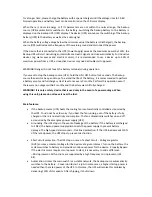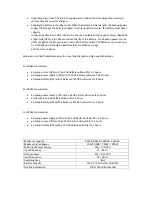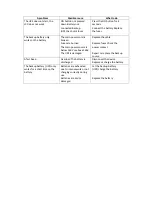
for a longer time, please charge the battery with a special charger until the voltage rises to 10.8V.
Normal operation and battery level can be monitored on the LCD color display.
When there is no main energy or if its parameters are not within the normal range, the backup
source (UPS) automatically switches to the battery. Switching the backup battery to the battery is
displayed on the Backup UPS (UPS) display. The device (UPS) announces the switching of the backup
battery (UPS) to the battery as well as the audio signal.
When the battery voltage drops below the minimum value (the battery is discharged), the backup
source (UPS) will increase the frequency of the warning sound and disconnect the power.
If the device that is connected to the UPS (Power Supply) exceeds the maximum power by 110%, the
Backup UPS will start delivering an intermittent acoustic signal and close automatically. For inductive
devices (eg, water pumps and electric motors), it is recommended to use a device up to 50% of
maximum power from a UPS, as inductive devices may need a double startup power.
WARNING! Danger! Do not touch the battery terminals during operation.
If you want to stop the backup source (UPS), hold the ON / OFF button for 4 seconds. The backup
source then emits a beep and stops. To extend the life of the battery, it is recommended to perform
a battery empty and full charge cycle at least once every 2 months. Perform this operation even if
there were no outages within 2 months and the battery was still fully charged.
WARNING! It is only a safety device that is used only in the event of a power outage. When
using this unit, please do not leave it near the fuel.
Main features:
If the backup source (UPS) heats the cooling fan is automatically controlled as required by
the UPS. You do not have to worry if you hear the fan running, even if the battery is fully
charged or there is no electricity consumption. The fan automatically switches on and off
as required by the emergency power supply (UPS).
Grounding: The UPS stops in the event of leakage of the battery. If the battery is discharged
to 10.8V, the backup power supply disconnects the power supply to prevent battery
damage. The high-speed alarm sounds: - Overload protection: If the UPS load exceeds 110%
of the rated power, the UPS stops to prevent destruction.
Short circuit protection: The UPS stops in case of a short circuit. - Voltage regulator
(AVR) ensures a constant voltage for the devices at a given interval. Turn on the battery: the
system switches to battery and provides continuous power for the device. -Property Bypass:
If the electric motor requires more power to start, it is necessary to add a difference.
–
Microprocessor: All functions are supported by a high frequency microprocessor (32
bit).
Automation: Unless the main switch is a suitable network, the backup source automatically
switches to the battery. - Conversion to start a job: In some cases, a higher startup power is
needed than the rated power of the UPS. In this case, the UPS will resolve this problem by
delivering 110% of its capacity. After shipping, it shuts down.






















